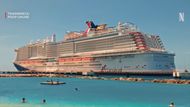Trainwreck: Poop Cruise sounds like a bad comedy sketch, but nope, it was real, it was nasty, and it was every germaphobe’s worst nightmare come to life. Picture this: no electricity, no plumbing, the scent of doom and sewage in the air, and over 4,000 passengers trapped in what quickly became one of the worst cruise experiences in history.
Toilets overflowed, food ran out, tents popped on deck like some post-apocalyptic summer camp, and red bags replaced bathrooms. The ship quickly turned into a fever dream of filth, despair, and makeshift tent cities. The headlines were wild, but the behind-the-scenes details? They’ll make your stomach turn and your next vacation plans more cautious. Here's everything you need to know about the nightmare that happened aboard the Carnival Triumph, and how they got out of it.
The real story behind Trainwreck: Poop Cruise

Netflix's Trainwreck: Poop Cruise chronicles the Carnival Triumph’s descent into chaos after a 2013 engine fire left over 3,000 passengers stranded in sewage-soaked hell. What started as a four-day trip to Cozumel turned into a nightmare: no power, no plumbing, and biohazard bags for toilets.
Carnival’s shady cost-cutting, like ignoring faulty generators, made the disaster inevitable. What followed was flaming engines, spoiled food, makeshift camps on deck, and literal rivers of human waste. When tugboats finally arrived, rough seas dragged the ship sideways to Alabama, turning the Carnival Triumph into a floating, festering symbol of corporate negligence and human misery.
How Netflix's documentary brings the horrors of Carnival Triumph to screen

Netflix’s Trainwreck: Poop Cruise dives headfirst into Carnival Triumph’s 2013 voyage from vacation dream to sewage-drenched nightmare. The docuseries spotlights the horrors everyone went through, with interviews of real-life people from the cruise. As shown, passengers squatted in showers, defecated in hazmat bags, and built tent cities on deck to escape the unbearable stench below. One group repurposed life vest beacons as flashlights to navigate pitch-black hallways, while others fought over lettuce sandwiches and clean spots to sleep.
The documentary balances absurdity and horror by spotlighting both vacationers and crew. A chef recalls discovering “poop lasagna” a multi-layered horror fest of waste and tissue in clogged toilets, while a Russian staffer compared the collapse to the Soviet Union. Meanwhile, tensions flared as guests tossed their biohazard bags overboard, only for them to land on other passengers. Carnival's cost-cutting choices, including setting sail with only four working generators, came under scrutiny as key contributors to the disaster.

By the time tugboats arrived to haul the ship sideways to Alabama, passengers were drunk, angry, and covered in filth, left with a nightmare of a memory, and possibly the fear of cruises altogether!
What happened to the passengers on Carnival Triumph?
After Carnival Triumph lost power in February 2013, Carnival’s first response was classic corporate damage control. PR rep Buck Banks issued a vague “holding statement” mentioning the propulsion loss, conveniently skipping the sewage rivers and non-flushing toilets. CEO Gerry Cahill followed with a polished apology, assuring that guests were “safe” and “as comfortable as possible.”
His statement read,
“All our guests are safe, and we’re doing everything we can to make them as comfortable as possible. We’re terribly sorry for the inconvenience, discomfort and frustration our guests are feeling.”
Families back home started contacting the media when they couldn’t reach loved ones, and CNN quickly realized this wasn’t a minor inconvenience. It was a full-on floating disaster. Two tugboats reached the ship by February 11, but strong Gulf currents had pushed the Triumph over 100 nautical miles off course. Instead of towing it to Mexico or Texas, rescuers had no choice but to drag the 900-foot ship north to Mobile, Alabama, a journey that took days, during which toilets overflowed, food rotted, and literal poop sloshed through hallways.
Passengers were finally rescued when the ship docked on February 14. They were met with blankets, food, and transport home, plus a $500 refund and a future cruise offer from Carnival. The company later promised a $500 million fleet-wide upgrade and a shiny new “Passenger Bill of Rights" that promises basic hygiene, safety, and amenities.
Trainwreck: Poop Cruise is available to stream on Netflix.
Love movies? Try our Box Office Game and Movie Grid Game to test your film knowledge and have some fun!
